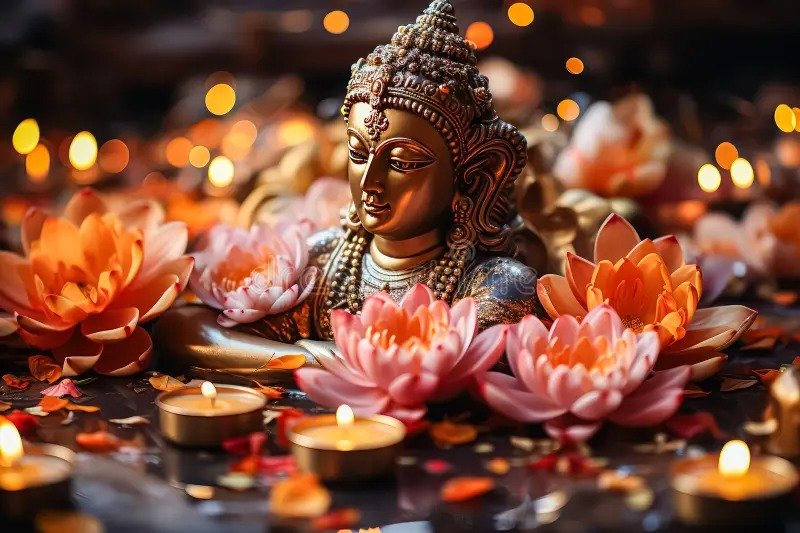By: Dipak Kurmi
Lakshmi Puja, or Lokkhi Pujo as it is known in parts of eastern India, is a deeply significant Hindu festival dedicated to the veneration of Lakshmi, the goddess of wealth, prosperity, and good fortune. As the Supreme Goddess of Vaishnavism, Lakshmi is revered across the Indian subcontinent and beyond. Her blessings are sought with great fervor, and her arrival is eagerly anticipated by millions of devotees who prepare their homes and hearts for this auspicious occasion.
Celebrated on the amavasya, or the new moon day, in the Hindu calendar months of Ashwayuja or Kartika, Lakshmi Puja often coincides with the third day of Deepavali in most parts of India and Nepal. However, regions like Bengal, Assam, and Odisha have their own unique timing and customs, with the puja occurring five days after Vijaya Dashami, following the conclusion of Durga Puja. This distinct regional variation adds to the cultural richness of the festival, making it a pan-Indian celebration that resonates with different traditions and practices.
At its heart, Lakshmi Puja is a celebration of the divine feminine and the blessings of prosperity and abundance that she bestows. Devotees believe that Lakshmi roams the earth on the night of her puja, seeking out homes that are clean, well-decorated, and filled with devotion. It is said that the goddess prefers to visit the cleanest houses first, and so the preparations for her arrival are meticulous. Homes are thoroughly cleaned, often days in advance, to ensure that they are spotless and inviting. Finery and lights adorn the household, while aromatic sweets and delicacies are prepared as offerings to welcome the goddess.
As the evening of Lakshmi Puja approaches, the air is filled with a palpable sense of anticipation. The symbolic act of opening doors and windows to invite the goddess into the home marks the beginning of the celebration. Diya lamps are placed on windowsills and balcony ledges, their warm glow flickering in the night, signaling an open invitation for Lakshmi to enter. This act of lighting diyas is not only a mark of devotion but also a way of illuminating the darkness, symbolizing the triumph of light over ignorance and the ushering in of prosperity.
Dressed in their finest clothes, devotees gather for the puja, which involves prayers not only to Lakshmi but also to other deities, depending on the region. Ganesha, the remover of obstacles, is often invoked at the beginning of the ceremony, ensuring that the path to prosperity is free of any hindrances. Saraswati, the goddess of learning, and Kubera, the treasurer of the gods, are also worshipped in many households, highlighting the multifaceted nature of wealth and success – beyond material riches to encompass knowledge and fortune.
Lakshmi Puja is not merely a celebration of wealth in its material form; it is a holistic festival that honours the values of family, tradition, and spirituality. Mothers, who work tirelessly throughout the year to nurture and sustain their households, are especially praised on this day. They are seen as embodiments of Lakshmi herself, the living symbols of prosperity and well-being in the family. This deep reverence for the mother figure elevates the festival beyond the pursuit of material wealth, grounding it in the values of gratitude, respect, and familial love.
In many regions, especially in Assam, Bengal, and Odisha, Lakshmi Puja takes on local flavours that enrich the festival’s significance. In Bengal, the Kojagori Lokkhi Pujo is celebrated five days after Vijaya Dashami, with the goddess worshipped at night, under the full moon. This variation is steeped in tradition, with the goddess represented in unique forms, such as banana trees, clay covers for utensils, and small boats carrying five drums. On Deepavali eve, also known as Dipanwita Lokkhi Puja or Alakshmi Viday, the goddess is worshipped once again, this time to bid farewell to her antithesis, Alakshmi, the bringer of misfortune.
In Assam and Odisha, the celebrations are similarly rich in tradition. Five days after Vijaya Dashami, families come together to decorate their homes, especially their entrances, to welcome the goddess. Prasad offerings typically include sweets, moong dal, gram, and fruits, all prepared with great care and devotion. The cleanliness of the home is paramount, as it is believed that Lakshmi will bless the cleanest homes with her presence. The act of drawing rangoli or alpona on the doorstep further signifies the welcome extended to the goddess, creating a beautiful and intricate path for her to enter.
Lakshmi Puja is also an important part of Tihar, Nepal’s second major festival after Dashain. In Nepal, the celebration stretches over five days, each day dedicated to a different deity or animal, including crows, dogs, cows, and oxen. The third day, however, is reserved for Lakshmi Puja, and it is on this day that the Nepalese people buy gold, silver, and new utensils as symbols of wealth and prosperity. These items are then used in the puja to honour Lakshmi, and homes are cleansed with holy water, cow dung, and red mud, preparing them for the goddess’s blessings.
The ritual of Lakshmi Puja varies from region to region, but certain elements remain central to the ceremony. The purification of the space is a key aspect, with devotees lighting benzoin incense to cleanse the atmosphere. The kalasha, a sacred vessel filled with water, betel nuts, flowers, and coins, is placed at the heart of the altar, symbolising abundance and prosperity. A Panchmukhi Diya, a special five-faced lamp, is lit, and the goddess is bathed in panchamrita, a mixture of milk, curd, ghee, honey, and sugar. This ritual cleansing is followed by offerings of flowers, sandal paste, saffron, and garlands, all given in reverence to the goddess.
In rural areas, the symbolism of prosperity is deeply rooted in the agricultural traditions of the land. A bamboo pot, known as ‘Mana,’ is filled to the brim with freshly harvested paddy, symbolising the abundance of the earth’s bounty. The goddess is worshipped with offerings of fruits, coconut, banana, and doob grass, while the reading of the Lakshmi Purana in Odia adds a spiritual dimension to the ceremony.
The culmination of Lakshmi Puja is marked by the aarti, a devotional hymn sung in praise of the goddess, accompanied by the ringing of a small bell. This final act of devotion is performed in a silent and sublime atmosphere, leaving the devotee with a sense of spiritual fulfilment and the hope for a prosperous year ahead.
Lakshmi Puja is not just a festival of wealth, but a celebration of life, family, and spiritual abundance. It is a time when the divine feminine is honoured, familial bonds are strengthened, and the blessings of prosperity are sought with devotion and humility. The festival weaves together the material and the spiritual, creating a tapestry of rituals and traditions that resonate with the values of generosity, cleanliness, and reverence for the divine. As the diyas flicker and the mantras are chanted, the presence of Lakshmi is felt not only in the wealth that she bestows but in the joy, peace, and well-being that fill the hearts and homes of her devotees. (The writer can be reached at dipakkurmiglpltd@gmail.com)












